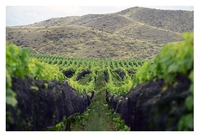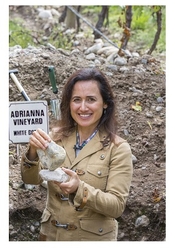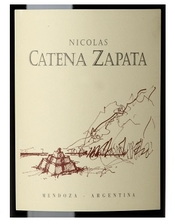 Nicolás Catena knew that as you went up, temperature went down, even more so at night, amplifying the difference between the daytime and nighttime temperatures. This greater diurnal temperature variation allowed grapes to retain acidity, which translated into fresher and more lively wines. Today, some three decades later, winegrowers try to combat climate change by either planting vineyards further north or south, depending on the hemisphere, or by “going up,” and planting at higher elevations. Stephen Brook, writing in Decanter, the world’s leading wine magazine, highlighted the importance of Catena’s philosophy for Argentina when he wrote, “Nicolás Catena thrust Argentinian wine into the modern era”…because he realized “the key was to plant the right varieties in the right location, specifically cooler, higher sites where jamminess would not be an issue.”
Nicolás Catena knew that as you went up, temperature went down, even more so at night, amplifying the difference between the daytime and nighttime temperatures. This greater diurnal temperature variation allowed grapes to retain acidity, which translated into fresher and more lively wines. Today, some three decades later, winegrowers try to combat climate change by either planting vineyards further north or south, depending on the hemisphere, or by “going up,” and planting at higher elevations. Stephen Brook, writing in Decanter, the world’s leading wine magazine, highlighted the importance of Catena’s philosophy for Argentina when he wrote, “Nicolás Catena thrust Argentinian wine into the modern era”…because he realized “the key was to plant the right varieties in the right location, specifically cooler, higher sites where jamminess would not be an issue.”
Although one might think that the enhanced light that results from thinner air at higher altitudes might burn grapes—we sunburn much more easily at higher altitudes—the more intense light aids photosynthesis, the vines’ energy source, without harming the grapes.
 All of which brings us to Adrianna Vineyard. Nicolás Catena planted the 30-acre vineyard at about 5,000 feet above sea level. Located in Mendoza, specifically in the Gualtallary District of Tupungato, Adrianna Vineyard is home to strange bedfellows. Malbec, Cabernet Sauvignon, and Cabernet Franc made sense, since these Bordeaux varieties are often planted together, but then there’s Chardonnay, Pinot Noir and Viognier, which I suppose is the first indication that this single vineyard, unsurprisingly, is not homogenous. More about that later.
All of which brings us to Adrianna Vineyard. Nicolás Catena planted the 30-acre vineyard at about 5,000 feet above sea level. Located in Mendoza, specifically in the Gualtallary District of Tupungato, Adrianna Vineyard is home to strange bedfellows. Malbec, Cabernet Sauvignon, and Cabernet Franc made sense, since these Bordeaux varieties are often planted together, but then there’s Chardonnay, Pinot Noir and Viognier, which I suppose is the first indication that this single vineyard, unsurprisingly, is not homogenous. More about that later.
Laura Catena, MD and Larry Stone, MS recently led a Zoom® tasting to discuss the concept of Grand Cru by tasting several of Catena Zapata’s wine and other great wines from Burgundy, Bolgheri, and the Willamette Valley. Though that discussion was informative, what I found most fascinating about the tasting was the diversity of wines, even made from the same grape, that came from within a single vineyard. It forced me to reconsider the idea of “single-vineyard” wines.
The San Bernabe Vineyard in Monterey County with its 8,500 acres of vines is reported to be the largest vineyard in the world. Compare that with Guigal’s famed La Mouline, which is roughly 2.5 acres. In between, in Burgundy, as Larry Stone pointed out, is the 45-acre Les Folatières vineyard, one of Puligny-Montrachet’s top premier crus. In reality, four distinct sites, what the French call lieux-dits (literally, place names), Peux Bois, Au Chaniot, Ex Folatières, and En la Richarde, comprise the Les Folatières vineyard. Producers can make and label their wine “Les Folatières” if the grapes came from one or more of the lieux-dits. Theoretically, there could be four distinct wines all labeled Les Folatières, made from grapes grown in the four lieux-dits. But, in reality, they are all labeled, Les Folatières. The same is true, on a larger scale, in the grand cru vineyard, Echezeaux. Eleven lieux-dits comprise this almost 100-acre-vineyard. There is no doubt that some sites produce better grapes than others. Indeed, producers know this and sometimes put the name of the lieu-dit on the label along with vineyard name, Echezeaux.
That certain portions of a vineyard produce better grapes is well-known by winegrowers around the world. Sections with older vines are treated with reverence. But vine age aside, certain plots, even a few rows of vines, within a vineyard are prized over adjacent ones. Winemakers might use these grapes for their “reserve” wines or special bottlings. The point is—a vineyard, regardless of size—is not homogenous.
All of which brings me back to Catena Zapata’s Adrianna Vineyard. We tasted three wines from Adrianna, a stunning 2017 Malbec and two incredibly different 2018 Chardonnays, labeled White Bones and White Stones.
The 2017 Malbec labelled “Fortuna Terrae” reminded me that this grape planted in the right spot and vinified by the right people can make wonderful wine. In my experience Malbec is all too often a big, heavy, one-dimension fruity wine displaying little or no complexity. Catena Zapata’s Fortuna Terrae does not fit that description. Yes, it’s a bold wine—it is Malbec, after all—but it’s not heavy. As it sits in the glass, complexity and minerality come out. The tannins are suave, and, as expected from the vineyard’s altitude, the wine is fresh and lively. Indeed, it’s a surprisingly floral and elegant Malbec.
The White Stones Chardonnay comes from a 6.2-acre parcel of the Adrianna Vineyard rich in rounded rocks covered in calcium carbonate, according to Catena. Weighing in at a modest 12.5 percent stated alcohol, it is restrained, yet paradoxically explosive. Tightly wound initially, with air it blossoms, showing a hint of spice that complements its front and center flintiness. Its mineral-y aspect stands out and grows with air. Lip-smacking acidity—there’s the effect of altitude again—amplifies its charms. You’d be forgiven if you identified it as a Grand Cru Chablis in a blind tasting.
The White Bones Chardonnay comes from a 5.4-acre parcel on a dried riverbed filled with crumbled limestone. Drawing on her specialty in Emergency Medicine, Catena said the area reminded her of broken bones. Despite its close proximity to the White Stones parcel, the White Bones was vastly different—far more floral and flamboyant, displaying herbal, almost minty, qualities that overshadowed any mineral aspects. It did, unsurprisingly, have the same mouth-watering freshness and a similarly modest, 12.6 percent, stated alcohol.
 The 2017 Nicolás Catena Zapata, the winery’s flagship—Catena calls it a “Super Argentinian”—provided an ironic counterpoint because it showed that a great wine need not be a single-vineyard wine. The 2017 Nicolás Catena Zapata is typically a blend of Malbec, Cabernet Sauvignon, and Cabernet Franc grown in a variety of their high-altitude vineyards. The Malbec came from Adrianna and Nicasia Vineyards, while the Cabernet Franc came from Adrianna, and the Cabernet Sauvignon from both Adrianna and La Pirámide vineyards. Similar to the Fortuna Terrae Malbec, Nicolás Catena Zapata is bold, but not heavy. Its complexity is riveting. Each taste reminds you you’re in for a treat. Acidity keeps it fresh and lively, which invites another sip. A youthful wine, to be sure, its texture and balance predicts a beautiful evolution. This gem is one for the cellar.
The 2017 Nicolás Catena Zapata, the winery’s flagship—Catena calls it a “Super Argentinian”—provided an ironic counterpoint because it showed that a great wine need not be a single-vineyard wine. The 2017 Nicolás Catena Zapata is typically a blend of Malbec, Cabernet Sauvignon, and Cabernet Franc grown in a variety of their high-altitude vineyards. The Malbec came from Adrianna and Nicasia Vineyards, while the Cabernet Franc came from Adrianna, and the Cabernet Sauvignon from both Adrianna and La Pirámide vineyards. Similar to the Fortuna Terrae Malbec, Nicolás Catena Zapata is bold, but not heavy. Its complexity is riveting. Each taste reminds you you’re in for a treat. Acidity keeps it fresh and lively, which invites another sip. A youthful wine, to be sure, its texture and balance predicts a beautiful evolution. This gem is one for the cellar.
Yes, the vineyard is important, but in my mind it’s still producer, producer, producer. So, it’s fine to remember the name of the Adrianna Vineyard. But, my advice is to remember the Catena Zapata name.
Photos Courtesy of Catena Zapata www.CatenaZapata.com
E-mail me your thoughts about Argentinian wine in general or Catena Zapata in particular at Michael.Apstein1@gmail.com and follow me on Twitter and Instagram @MichaelApstein.
